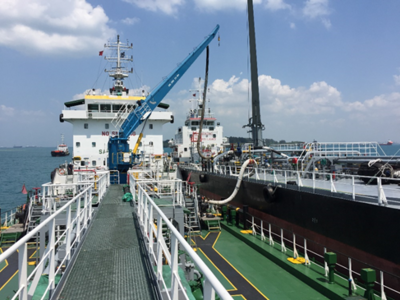NEWS & ARTICLES
Enabling Bunkering Productivity Improvements with Mass Flow Metering
Bunkering industry is important to Singapore’s economy. Bunkering is the process of supplying essential transport fuels to ships at seaports. Singapore is the world’s largest and leading bunkering port, supplying ships calling at Singapore’s port with more than 48 million metric tonne of bunker fuels in 2016 alone, according to the Singapore’s Maritime and Port Authority. This translates to more than $29 billion of bunker fuels traded!
Ship Bunkering Needs Better Measurement
Currently, the most common method of measuring the quantity of fuels traded in bunkering is through tank gauging, or commonly known as dipstick method. The method, which measures fuel quantity indirectly, has been used by the bunkering industry for decades. Instead of measuring mass directly, teams of bunker surveyors have to determine the amount of fuels transacted based on bunker tanks’ dimensions, dipstick readings and the fuels’ density data. The measurement is significantly affected by sea waves, vessel’s inclination and non-uniformity of the tank, and the process is labour intensive, limiting the ability of the industry to carry out transactions in an efficient and transparent way. Without reliable and scientifically robust measurement, it would be difficult to have satisfactory resolution should disputes arise concerning the actual amount of fuels transacted. Owing to the laborious nature of tank gauging operation, it is also very difficult to meaningfully improve operational productivity.
Mass Flow Metering for Bunkering
Mass flow metering has the obvious advantages over tank gauging in determining the amount of fuels transferred in bunkering. Its principle is based on direct measurement of the mass of fluids flowing through the meter (for more information on mass flow meter, please refer to the article on Inline Liquid Flow Measurement Using Coriolis Mass Flow Meters). This direct traceability to the unit of mass, the kilogram, through gravimetric calibration greatly improve the accuracy and reduce the influence of environmental factors such as wavering of ships. Mass flow metering systems can also be securely sealed, lowering the risk of unauthorised tempering of the system, and enhancing trust and confidence in the transactions.
In addition, Coriolis flow meters also has the advantage in that measurements are done automatically, and measurement results can be obtained instantly and made available to all parties concerned. Instead of the manual and laborious process of surveying and gauging, Coriolis flow meters enable the users to automate the measurement, thus raising the productivity and enhancing reliability of the bunkering process.
The Challenges
A bunkering process normally involves a starting session, which is a necessary step for bunker barges to pack the pipeline, and an ending session, during which the pipeline is cleared. During packing and clearing, air entrainment in the pump or pipeline tends to occur, giving rise to multiphase flow condition. Multiphase condition affects the density of the fluid flowing through the meter. Since mass flow meters are sensitive to the fluid density, multiphase condition could potentially cause significant errors in the measurement.
Mass flow metering system consists of not only the meter but also pipelines, pumps and valves, and each part of the system contributes to inaccuracy (or, in metrological term, measurement uncertainty). Hence, it is not just the accuracy of the meter that affect the reliability of the measurement. Factors such as how the meter is installed, multiphase condition, flow direction, flow fluctuation and fluid viscosity also contribute to the measurement uncertainty. Typically, measurement uncertainty attributed to these other factors constitute about 50% of the total uncertainty. To minimise measurement uncertainty due to these factors, a more robust measurement procedure has to be put in place.
Another potential error involving the use of mass flow meter comes from the viscosity of bunker fuels which is much higher than other fluids that mass flow meters normally handle. These complexities have so far limited the adoption of the technology in bunkering.
Enabling Mass Flow Metering for the Bunkering Industry
In 2009, Singapore began a programme to adopt mass flow meters for bunkering, and to enable the adoption, NMC carried out research to develop a measurement method to overcome the limitations. The method involved: (i) determination of measurement errors due to viscosity effects; (ii) requirement for bunker barge operators to follow processes to limit multiphase flow; (iii) on-board acceptance test to qualify mass flow metering systems before they are approved for custody transfers in Singapore maritime port.
With the measurement method developed, and collaborative efforts of maritime stakeholders and the bunkering industry, Singapore launched the first Technical Reference on “Mass Flow Metering for Bunkering” on 16 February 2016. From 1 January 2017, the use of mass flow metering system is mandatory for bunkering done at Singapore port, making Singapore the first bunkering port in the world to officially adopt mass flow meter for custody transfers. Over the last three years, measurement data from acceptance tests done on more than 100 metering systems were validated by NMC, which helped the bunker operators qualify the metering systems, and raise the productivity in bunker fuel custody transfers. This work has led to 3% improvement in efficiency in the bunkering industry.
A*STAR celebrates International Women's Day

From groundbreaking discoveries to cutting-edge research, our researchers are empowering the next generation of female science, technology, engineering and mathematics (STEM) leaders.
Get inspired by our #WomeninSTEM
